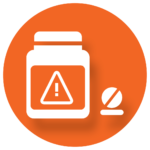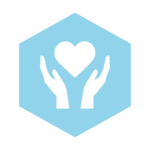
Service Area
The Springfield Community is made up of 3 Missouri counties: Christian, Greene and Webster Counties. On the Ozarks Health Commission, CoxHealth System, Mercy Hospital System, Burrell Behavioral Health, Jordan Valley Community Health Center, Christian County Health Department, Springfield-Greene County Health Department and Webster County Health Department represent the Springfield Community.
CoxHealth System is the largest employer in the Springfield region, offering high-quality medical services to populations in Southwest Missouri and Northwest Arkansas. The not-for-profit health system, headquartered locally, has two large campuses and a total of 31 CoxHealth facilities in Springfield, ranging from walk-in clinics to the Cox Medical Center South Emergency and Trauma Center and from the Meyer Orthopedic and Rehabilitation Hospital to the CoxHealth Surgery Center.
Mercy Hospital system serves millions each year. Mercy is a cutting-edge healthcare provider that is charged with “providing the region with high-quality care and an experience that is easier and more personal.” Mercy Hospital Springfield houses 886 beds that serve people throughout Southwest Missouri and Northwest Arkansas.
Burrell Behavioral Health is the third largest Certified Community Behavioral Health Center in the nation with multiple locations throughout Springfield and surrounding areas. Burrell has more than 400 licensed providers offering a full continuum of care through their integrated network. Burrell has continued to expand their reach and partnerships in the community through offering community-based services in coordination with schools and other organizations, such as Boys & Girls Clubs Springfield to meet the behavioral health needs of the community.
Jordan Valley Community Health Center is Missouri’s largest Federally Qualified Health Center serving 75,000 patients in the Ozarks each year. Founded in 2003, their mission to improve the community’s health through access and relationships has driven their growth from their first medical clinic located in a strip mall to nine clinics, three school-based clinics and a fleet of mobile units that visit schools and organizations providing medical, dental, vision and behavioral health care services in southwest Missouri. Jordan Valley Community Health Center provides an integrated model of care, simplifying healthcare by giving access to a multitude of services in each clinic.
In 1968 a public health office was established in Ozark, Missouri, under the auspices of the Ozarks Area Community Action Agency Corporation, with funding shared by the federal government and the Missouri Department of Health. Two years later the Christian County Health Department (CCHD) was created by a vote of the residents of the county. CCHD’s mission is to serve and protect the county citizens by promoting healthy behaviors, increasing understanding of health issues and improving the quality of the environment. The department offers a variety of programs to serve the needs of Christian County residents.
The Webster County Health Department (WCHD) was established in 1957 in order to preserve and protect public health of the community. WCHD’s focus is on teaching, protecting and empowering people so that they don’t get sick. By providing vaccinations, offering nutrition education, ensuring clean water and safe food, and providing screening and testing services, WCHD protects individual and community health.
Springfield-Greene County Health (SGCHD) was established by the City of Springfield in 1873 as the Springfield Department of Health. The name was changed, and services were expanded to the entire county in 1976. The mission of SCGHD is to protect and improve community health through education, collaboration and prevention. Through chronic disease prevention, community health & epidemiology, environmental health and other programs, SGCHD can help the citizens of Greene County live longer, happier and healthier lives.
Population Overview
More than 414,000 residents call the Springfield Community home, and it only continues to grow. Between 2000 and 2010, there was nearly a 20% increase in total population followed by a smaller, but still significant, increase of 10% in the years between 2010 and 2020. Roughly evenly split among men and women, almost 15% of those who call the Springfield Community home describe living with a disability and about 6% claim veteran status.
Those that live in this community overwhelmingly identify as Non-Hispanic White persons who were born in the United States. These citizens, however, are not the only people shaping the vibrant Springfield Community. Self-identified persons of color compose more than 10% of the Springfield Community’s population. Many more have come to live in this community after being naturalized, born abroad, or born in a US Territory. Close to 5,700 people (slightly more than 1% of all residents) are not US citizens but have chosen to bring their talents and perspective to the Community.
Three in four community residents live in a census tract designated as ‘urban’. Amongst rural and urban residents, about 28% of families have children under the age of 18 living at home. In fact, more than 20% of the community is comprised of individuals younger than 18 years old. Seniors, those age 65 and older, make up about 16% of the total population.
Understanding community-wide disparities and challenges while also ensuring that each of the individuals that comprise the Springfield Community have the opportunity to live meaningful, healthy, and long lives is the purpose of this assessment.
SPOKEN LANGUAGES
More than 95% of residents in the Springfield Community speak English only. However, many other languages are spoken within the Community. The following is a list of languages spoken by more than 300 members of the Community (roughly 0.10% of the population).
- Spanish (2.1%)
- German (0.7%)
- Chinese (<0.5%)
- Vietnamese (<0.5%)
- Russian (<0.5%)
- Hmong (<0.5%)
- Tagalog (<0.5%)
- French (<0.5%)
- Korean (<0.5%)
- Arabic (<0.5%)
(American Community Survey, 2015-2019)
In addition, in 2022, the Springfield-Greene County Health Department surveyed employees who collect primary language information from the clients they serve. The most common primary languages for these clients include:
- Spanish
- Vietnamese
- Russian
- Pashto
- Ukrainian
Other, less commonly encountered primary languages, include Hakha Chin, ASL, Hindi, Swahili, Dari, Mandarin, Arabic, and Portuguese.
Populations of interest
While understanding the health of each person living in the Springfield Community is imperative, some subsets of the population have disparate needs and challenges. Historically disenfranchised populations – such as people in poverty, minorities and the elderly- often experience higher rates of chronic illness and worse health outcomes, due to a multitude of structural and environmental factors. This can lead to health disparities between various socioeconomic classes and/or demographic groups.
Using the Centers for Disease Control and Prevention (CDC) Social Vulnerability Index1, the OHC identified key factors, or populations, to consider when developing actions to improve prioritized health needs. The table below includes percentile rankings (values range from 0 – 1), with higher values indicative of greater vulnerability for each population. It also highlights populations that are 80%, 85%, and 90% more vulnerable than the same population in other counties in its respective state. For example, Webster County has more youth than 99% of counties in Missouri- Christian County has more than 95% of Missouri counties. For more information about the methodology used in the CDC’s Social Vulnerability Index can be found on their website.
Those living in the Springfield Community are nearly 80% more likely than other Missourians to live in multi-unit structures and are 77% more at-risk of living in a crowded home. Though a relatively small percentage of community residents are not native US citizens, residents report speaking English ‘less than well’ at a rate higher than 74% of Missouri counties. These examples indicate known barriers to health and healthcare, which is why populations experiencing these issues are of special interest in this assessment. The needs of children aged 18 years and younger, those living in crowded or multi-unit housing, and those who may have health literacy challenges should be considered when developing Community Health Improvement Plan (CHIP) strategies for this area.
| Christian County | Greene County | Webster County | Springfield Community | ||
| Socio-Economic Status | Below Poverty | 0.08 | 0.67 | 0.54 | 0.43 |
| Unemployed | 0.33 | 0.38 | 0.46 | 0.39 | |
| Income | 0.20 | 0.24 | 0.74 | 0.39 | |
| No High School Diploma | 0.08 | 0.10 | 0.52 | 0.23 | |
| Household Composition & Disability | Aged 65+ | 0.12 | 0.18 | 0.18 | 0.15 |
| Under Age 18 | 0.95 | 0.16 | 0.99 | 0.70 | |
| Disability Status | 0.14 | 0.27 | 0.27 | 0.23 | |
| Single-Parent Households | 0.51 | 0.36 | 0.23 | 0.37 | |
| Minority Status & Language | Minority | 0.55 | 0.77 | 0.38 | 0.57 |
| Speaks English “Less than Well” | 0.61 | 0.73 | 0.89 | 0.74 | |
| Housing Type & Transportation | Multi-Unit Structures | 0.75 | 0.97 | 0.65 | 0.79 |
| Mobile Homes | 0.12 | 0.05 | 0.54 | 0.24 | |
| Crowding | 0.69 | 0.67 | 0.96 | 0.77 | |
| No Vehicle | 0.00 | 0.70 | 0.75 | 0.48 | |
| Group Quarters | 0.01 | 0.76 | 0.61 | 0.46 | |
| Orange highlight | The population in this county is more vulnerable than 90% of all other counties in its respective state. | ||||
| Blue highlight | The population in this county is more vulnerable than 85% of all other counties in its respective state. | ||||
Assessed Health Issues
OHC Region stakeholders began the RHA process with analysis of publicly available health data (secondary data) and participating health systems’ emergency department utilization data (primary data) to identify health issues of greatest concern across the region. The result was a ranked list of eight Ozarks Health Commission Region health issues. A full description of the health issues and indicators used can be found in the OHC Regional Health Assessment.
To represent diverse views from across the region and population, qualitative data was collected between September and October 2021. Across the OHC Region these viewpoints were solicited via 75 individual interviews, 10 focus groups and 2,638 surveys. Specifically in the Springfield Community, 20 individual interviews were held with stakeholders and 3 virtual focus groups were held with local health system leaders, community outreach organizations, and a local drug task force as well as other sectors of the Springfield Community to allow voices to highlight challenges that they see as the biggest health related needs. Further, approximately 31% of regional survey respondents were from the Springfield Community.
Methodologies used for the initial scoring/ranking of the health issues and the full report of the qualitative work can be found in the OHC Regional Health Assessment. This prioritization information can be used by organizations to develop community health improvement plans, guide decision making, foster collaboration across initiatives for collective community impact and increase funding by using evidence to describe issues and propose solutions.
Springfield Community Health Priorities
(click a health priority below to learn more)
Each OHC Community convened stakeholders to assess the feasibility and readiness to address the health issues identified through emergency department and public health data sources, and further evaluate the qualitative feedback that was garnered through community input (interviews, focus groups and survey responses). In the Springfield Community, Springfield-Greene County Health convened a series of virtual community stakeholders’ meetings in December 2021 and January 2022. Efforts were made to engage all public health agencies in the Community (Christian, Greene and Webster Counties), healthcare partners (CoxHealth and Mercy Springfield), mental healthcare partners (Burrell Behavioral Health), Federally Qualified Health Centers (Jordan Valley Community Health Center) and organizations engaged by Crescendo Consulting.
Based on the eight health issues identified by OHC using publicly available and participating health systems’ data, stakeholders from the Springfield Community were convened to further consider and identify the top priorities for the community to focus efforts over the next 3 years. During the meetings background data information was given to all participants along with context data gathered through community input. The participants used this information along with their own assessment of feasibility and readiness to change the health issues to answer a survey that was deployed and open for one week. The stakeholders further met to discuss the results of the survey and further rank the issues according to feasibility and readiness to change discussion.
Feasibility of changing each issue and readiness to address each issue was assessed through survey and stakeholder discussion and further ranking. Feasibility rankings were influenced by stakeholders’ perceptions of the readiness of the community to address an issue, existing initiatives or momentum, whether leadership was established around the condition, perceived feasibility to change, complexity of the issue and the time frame to improve the issue (within 2-3 years or more than 2-3 years).
The table shows Springfield Community health issue rankings based on primary and secondary data (left) and the change after feasibility rankings were included (right). The higher the score, the more significant the impact of the condition on the community, and the less difficult the condition is to address. It should be noted that feasibility was assessed using a 4-point scale, and the difference between the highest and lowest scores did not shift dramatically when the feasibility and readiness scores were included.
| Rank | Initial Ranking Primary & Secondary Data | Final Ranking Primary, Secondary & Feasibility Data | Rank Change | ||
| 1 | Mental Health | 3.25 | Mental Health | 2.94 | No change |
| 2 | Substance Use & Recovery | 2.69 | COVID-19 | 2.78 | +1 |
| 3 | COVID-19 | 2.58 | Substance Use & Recovery | 2.66 | -1 |
| 4 | Lung Disease | 2.52 | Lung Disease | 2.58 | No change |
| 5 | Heart Disease | 2.31 | Diabetes | 2.52 | +1 |
| 6 | Diabetes | 2.30 | Oral Health | 2.47 | +1 |
| 7 | Oral Health | 2.22 | Heart Disease | 2.42 | -2 |
| 8 | Cancer | 2.17 | Cancer | 2.15 | No change |
Mental Health
Mental health includes a person’s emotional, psychological and social well-being. It affects how individuals think, feel and act. A person’s mental health status also contributes to how they handle stress, relate to others, and make choices. Mental health is important at every stage of life, from childhood and adolescence through adulthood. Many factors contribute to mental health problems, including biology (factors such as genes or brain chemistry), life experiences (such as trauma or abuse) and family history. Within the broad category of mental health, mental illness specifically refers to all diagnosable mental disorders. Mental illness can be chronic or acute. An acute mental health crisis will require different intervention than managing a chronic mental illness2.
Community-level data used to analyze and prioritize mental health is limited, but what local data is available is convincing and of great concern among care providers, public health and healthcare partners, media and the community. Poor mental health, the number of self-reported poor mental health days in a 30-day period, and the rate of depression in the Springfield Community is higher than in Missouri and the U.S. Moreover, the Springfield Community has a suicide mortality rate 60% worse than the national average. Unfortunately, the rate of suicide mortality is worsening since the last assessment, with the 2015-2019 aggregate rate increasing 30% since the 2011-2015 assessment.
Twenty-eight percent of all emergency department visits associated with an assessed health issue were due to mental health or substance use in the Springfield Community.
The rate of mental health providers in the Springfield Community is one of the highest in the OHC Region at 85.3 providers per 100,000 residents. In fact, the Springfield Community’s rate of mental health providers is in the top 10% in the United States. However, this is still not meeting the demands for mental health care, as evidenced by long waits to access care in the Community. Additionally, more than 15% of adults and 7% of children are completely uninsured in the Community. In hospital emergency departments, one in three patients self-paid for services. Concerningly, the most common method of payment for mental health related visits was Medicaid, indicating a financial or lifestyle hardship for these patients.
The COVID-19 pandemic will have meaningful health consequences beyond the acute phase of the pandemic. In the OHC Region, two in 3 residents report that their social isolation has ‘worsened’ over the course of the pandemic. More than half report that COVID-19 has affected their mental health or the mental health of someone who lives with them. Of those with children at home, 70% say that children have been affected by the COVID-19 pandemic. Community stakeholders recount that the COVID-19 pandemic has made mental health more relevant. They are seeing “…very little treatment options and very few therapists who work with children”. Anecdotally, providers and community members say they feel that mental health conditions worsened during the COVID-19 pandemic. However, analysis of emergency department utilization data show that diagnoses of mental health conditions declined 10% between 2018 and 2020.
Substance Use & Recovery
Substance use as a behavioral health disorder, known as a substance use disorder (SUD), encompasses the use of intoxicating substances in a manner which negatively effects the persons global wellness. For the purposes of this report, substances abused include, but are not limited to, alcohol, opiates, stimulants, narcotics, benzodiazepines, and other prescribed or illicit substances that could cause poisoning. (Not included are things like carbon monoxide poisoning, pesticides, or venomous animals or plants.)
Recovery from substance use disorder is a process through which the individual improves that health and wellness, starts living a self-directed life and striving to reach a more fulfilling purpose. This comes in a variety of pathways, from public health and behavioral health providers, social supports, community resources and mutual aid. There are currently 22.75 million individuals openly in recovery in the US. Only 1 in 4 people needing substance use support and assistance will receive services3.
Slow progress on stigma, but it’s still progress. Awareness at Olympics helps, but it’s very stigmatized. I keep hearing things like, “I thought I was alone in this.” Still siloed for co-occurring treatment – most treatments still pay attention to one side or the other, not looking at whole package.
Springfield Community member
In the Springfield Community, substance use and recovery ranked second among the assessed health issues when considering public health and hospital data. The prevalence of substance use disorder (among Medicare patients) is greater than the entire OHC Region, Missouri, and the U.S. at 4.1%. This translates to a higher rate of drug poisoning mortality than the region, state, and nation, with 27.5 deaths per 100,000 being from drug poisoning. This is 25% higher than the national average and has increased by 28% since the 2019 community health needs assessment.
One in three emergency hospital visits for substance use or mental health are paid through Medicaid which indicates a financial or lifestyle hardship for the patient. Concerningly, the second most common way of paying for an emergency department visit associated with a substance use or mental health diagnosis is through self-pay. This indicates that the patient will be required to pay for the visit out-of-pocket or that the hospital will use safety net funding.
As with Mental Health, further prioritization could build on momentum of previous community health improvement plans. Newer efforts like the Burrell Behavioral Crisis Center, mental health first aid, Jordan Valley Community Health Center’s substance use services, criminal justice community health advocates and other treatment programs will continue to provide service to the Community.
The perceived feasibility of future solutions is high. Half of the community leaders surveyed felt that the Springfield Community had some or total local control necessary to impact policy change related to SUD and that there was a path of what is needed to positively impact this health issue. Seventy-five percent noted that leadership is in place for efforts and all respondents were able to point to a community partnership already in place.
In the community input process, substance use treatment and rehabilitation services, including detox was the fourth most important health issue among community input survey respondents, and substance use education, prevention and early intervention ranked fifth. When the issue was addressed in more detail through interviews and focus groups, support for more strategies was voiced, such as more and higher quality medical detox facilities. This demonstrates an understanding among the community of the importance of addressing this health issue.
Diabetes
Diabetes is a chronic health condition that affects how your body turns food into energy. If you have diabetes, your body either doesn’t make enough insulin or is resistant to the effects of insulin, leading to high blood sugar levels in the bloodstream. Over time, this can cause damage to multiple organs in the body, including the eyes, nerves, blood vessels and kidneys. It can also increase the risk of cardiovascular disease, decrease the body’s immunity and lead to decreased life expectancy.
One in five adults in the U.S. have diabetes and do not know it. Diabetes was the seventh leading cause of death in the U.S. in 2019, accounting for 87,647 deaths annually. Direct medical costs and lost productivity attributed to diabetes was estimated to be $327 billion in 20174. The Springfield Community has a higher rate of diabetes than the OHC Region, Missouri and the U.S., and this issue continues to grow, with the prevalence of diabetes increasing 30% since the 2019 assessment. Women are more likely to require an emergency department visit due to diabetes, making it the only assessed health issue besides lung disease to affect women more than men.
Some people can control their blood sugar levels with healthy eating and exercise, practices that will also improve cardiovascular and mental health. However, as diabetes progresses, multiple oral and injectable treatments (e.g., insulin) may be needed to control blood sugar levels. Diabetic complications may develop in other organ systems (i.e., the cardiovascular system, kidneys, eyes and nervous system), and more extensive care and treatment may be needed.
Type 2 diabetes is the most common form of diabetes, accounting for 90-95% of diabetes cases nationwide. It develops over many years and is usually diagnosed in adults. More than one in three adults in the U.S. have prediabetes, but more than 80% are not aware they are prediabetic. In prediabetes, blood sugar levels are higher than normal, but not high enough to be diagnosed as type 2 diabetes.
The progression to diabetes can be prevented or delayed with dietary changes and an active lifestyle. However, the rates of obesity and poor physical health in the Springfield Community are higher than the national average. Obesity is caused by a number of overlapping factors. A person’s home or workplace can promote gaining weight, this is referred to an obesogenic environment. Modifying these environments at community and policy levels can decrease the risk of developing obesity and diabetes. For instance, workplaces can adopt wellness policies that promote or incentivize healthy eating and physical activity.
Community stakeholders surveyed overwhelmingly believe this is a health issue that can be improved within 2-3 years. Leaders point out that ‘changing the culture of how we live’ could be a solution for better health. Working with children and families, providing education and demonstrations for eating healthier, reducing obesity and avoiding diabetes will help.
Change the culture of how we live. This starts with children and their families: cooking classes with healthy food, have the right support for their needs. Healthy culture and lifestyle, including mental health support. Education for disease states, how to avoid diabetes, obesity.
Springfield Community member
Through community input and survey, diabetes was recognized as needing the most focus for improvement over all other health issues, except mental health and substance use. A recent survey of residents in the OHC Region suggests that health behaviors most impacted by the COVID-19 pandemic include diet (43% of respondents say this behavior has ‘worsened’) and exercise (40% say behavior has ‘worsened’.) Results from the same survey indicate that 45% of residents believe that programs for diabetes prevention, awareness, and care are ‘very needed’.
Special Health Issue: COVID-19
Coronavirus disease (COVID-19) is an infectious disease caused by the SARS-CoV-2 virus. Most people infected with the virus experience mild to moderate respiratory illness and recover without requiring special treatment. However, some become seriously ill and require more advanced medical care. People over the age of 64 and those with underlying medical conditions like cardiovascular disease, diabetes, chronic respiratory disease or cancer are more likely to develop serious illness. Even after recovery, some people may have post-COVID conditions. These conditions can present as different types and combinations of health problems for different lengths of time. Multiorgan effects can affect many body systems, including heart, lung, kidney, skin and neurologic functions.
The first case of COVID-19 in Greene County was confirmed on March 12, 2020. Five days later, on March 17, the City and County placed a limit on gatherings of more than 10 people, followed by a county-wide stay at home order on March 24. This order stayed in place until May 4, 2020. In Christian County, the cities of Nixa and Ozark implemented stay-at-home orders on March 18, 2020, both lasting until May 3, 2020. Missouri implemented a statewide stay-at-home order on March 24, expanding prevention measures to Webster County and the remainder of Christian County.
Near the conclusion of the stay-at-home order, the City of Springfield and Greene County implemented a joint Road to Recovery plan, which included the passing of a city-wide masking ordinance beginning July 16, 2020. In Christian County, the cities of Nixa and Ozark implemented masking requirements within city limits on October 21, 2020.
As hospitalizations due to COVID-19 increased, shortages in staff and supplies resulted in elective and preventative procedures and health visits being postponed or cancelled. On July 15, 2020, when there were 39 people admitted in Greene County hospitals with COVID-19, CoxHealth opened the first COVID-19 intensive care unit in the Springfield Community in response to rising severe illness and hospitalizations.
By the end of 2020, the vaccination effort was in its infancy as the Community continued with preventative measures like masking and occupancy restrictions. The Pfizer-BioNTech COVID-19 vaccine received Emergency Use Authorization (EUA) from the FDA Dec. 11, followed by the Moderna vaccine Dec. 18. Nurses at Mercy Springfield received the first COVID-19 vaccines in the Springfield Community on Dec 13, 2020.
COVID exacerbated childcare issues in the community with facilities being closed due to outbreaks or staffing capacity demands. “Some childcare programs closed during COVID and have not reopened. The need outpaces the capacity even without COVID. Quality is also an issue.
Springfield Community member
At the start of 2021, Springfield and Greene County prioritized the vaccination effort. Distribution of the vaccine in the county followed the recommended phases outlined by the state. All Missouri residents over the age of 18 were eligible for vaccination by April 9, 2021.
Throughout the spring of 2021 cases began to slow. The average weekly case count in Greene County was under 20 per day when City of Springfield repealed the last masking mandate in the state on May 17.
Cases increased with the emergence of the Delta variant, which brought national attention to Southwest Missouri in summer 2021. At the height of Delta near the end of July, over 250 people were admitted to Greene County hospitals, and more than a third of patients were in critical care. Most of these patients were unvaccinated.
Pfizer received EUA for pediatric vaccine doses in late October, and the health departments and healthcare providers began vaccinating children ages 5-11 on Nov. 4, 2021. The end of 2021 saw the emergence of another new variant: Omicron. Cases began to spike in the Springfield Community near the end of November and rose quickly through the end of the year into January 2022. Vaccination and testing remained at the forefront of the pandemic response in the Community as Omicron spread. Throughout the pandemic, the community pulled together for multiple testing and immunization events.
The onset of the COVID-19 pandemic greatly impacted all aspects of health care and public health, which is evident through its inclusion as an assessed health issue.
The Springfield Community had a COVID-19 case rate that was slightly higher than the national average and about 15% higher than the state. Mortality rates were similarly distributed, slightly higher than the national rate and 15% higher than the state mortality rate, as of Oct. 29, 2021. Rates between communities are extremely variable, with Christian County showing a rate that was 21% lower than that of Webster County. Of course, COVID-19 data for the community is limited due to testing availability in some areas, the increased use of at-home tests and undercounting asymptomatic cases if the patient does not seek testing.
The Springfield Community was more aligned with the Missouri average on vaccinations, with roughly 5 in 10 persons over 18 vaccinated, as of October 29, 2021. National vaccination rates saw closer to 6 in 10 persons. These rates were consistent throughout the Community with only a 2-percentage point difference between the least vaccinated (Webster) and most vaccinated (Greene) counties.
COVID-19, per community and stakeholder feedback, is virtually impossible to separate from the other assessed health issues in the Springfield Community. Therefore, the committee deemed its inclusion as a special health issue appropriate.
Based on survey results in the Ozarks Health Region, 56% of respondents report that COVID-19 affected their mental health or that of someone who lives with them. Community members also reported a change in everyday health behaviors, due to COVID-19. Respondents noted a negative change in social isolation (66%), diet (43%), and exercise (40%).
The full impacts of the virus will be seen in the months and years to come, so it will be prudent to continue evaluation of its impact.
Social Determinants of Health
(click a social determinant of health below to learn more)
Additional data critical to understanding the health of the population and the vulnerability of the Community was discerned by examining six groupings classified as Social Determinants of Health: Economic Stability, Education Access and Quality, Healthcare Access and Quality, Neighborhood and Built Environment, Social and Community Context and Health Behaviors. The social determinants of health have a major impact on people’s health, well-being and quality of life while also contributing widely to health disparities and inequities. Therefore, examination of these factors is important as they play a significant role in the impact the assessed health issues have on the Springfield Community.
Economic Stability
In the United States, 3 in 10 people live in poverty, and many people can’t afford things like healthy foods, health care, and housing. People with steady employment are less likely to live in poverty and more likely to be healthy, but many people have trouble finding and keeping a job. People with disabilities, injuries, or conditions like arthritis may be especially limited in their ability to work. In addition, many people with steady work still don’t earn enough to afford the things they need to stay healthy.
In the Springfield Community, more than 1 in 3 people (37.1%) live at or below 200% of the Federal Poverty Level (FPL), meaning a family of four cannot earn more than $25,750 annually. The poverty rate among children is even higher in the Community, with nearly 45% of children living in poverty. In Webster County, this rate is more than 1 in 2, with 53.9% of children living in poverty.
In addition to living in poverty, affordable housing is a challenge for many. In the Springfield Community, 28% of residents live in substandard housing and 12% report a severe housing cost burden. Less than 1 in 3 people in the Community currently have affordable housing, meaning that most residents make at least 60% of the area’s median income. This in turn affects the resources that families must pay for other necessities, such as health care or nutritious food, leading to worse health outcomes.
Education Access & Quality
Education can be an indicator of health, with persons with higher levels of education often living healthier and longer lives. The rate of high school completion, or equivalent, in the Springfield Community is 14% higher than Missouri’s rate and 28% higher than the U.S. However, the chronic absence rate for children under the age of 18 in the Community is 30% higher than the state average. Greene County accounts for much of this disparity with a rate of chronic absence, at 19.6%, more than double the rates in Christian and Webster Counties. Moreover, the Springfield Community has a lower rate of higher education completion than both Missouri and the U.S., with roughly 10% fewer people completing an Associate’s or bachelor’s degree or higher than the rest of the nation.
However, the chronic absence rate for children under the age of 18 in the Community is 30% higher than the state average. Greene County accounts for much of this disparity with a rate of chronic absence, at 19.6%, more than double the rates in Christian and Webster Counties.
Moreover, the Springfield Community has a lower rate of higher education completion than both Missouri and the U.S., with roughly 10% fewer people completing an Associate’s or bachelor’s degree or higher than the rest of the nation.
Healthcare Access & Quality
Many people in the United States don’t get the health care services they need. About 1 in 10 people don’t have health insurance. In the Springfield Community, the rate of uninsured is even higher, with more than 15% adults and more than 7% of children not having health insurance. People without insurance are less likely to have a primary care provider, and they may not be able to afford the health care services and medications they need. In addition, people may not trust the healthcare system. Some reasons for this may include lack of cultural awareness by providers, feeling unwelcome or uncomfortable in traditional clinical settings, previous negative experiences with healthcare providers, insufficient accommodations for the disabled, language barriers or clinics not having convenient times or locations5.
Those with the financial means to access healthcare in the Springfield Community have more primary care, mental health and dental providers to seek services with than the rest of Missouri and the U.S. However, the Community has less than a quarter of average rate of substance use providers than the rest of the country. And while there are more providers for many health areas, Community members have identified that “Providers are overburdened and understaffed and don’t have time to provide individual care. It’s hard to get people to work in healthcare in rural areas, physicians, community health workers, admin staff, dentists, psychiatrists.” Moreover, Community members commented, “There is a lack of public transportation in rural areas and people may have to leave hours early for an appointment and there are delays. Medicaid supported transportation is not always reliable. The transportation options can be difficult to coordinate.”
Health Behaviors
Health behaviors include individual-level behaviors, often influenced by access or quality of services, that can impact the overall health of an individual or community. Measured health behaviors include physical activity, fruit and vegetable expenditures, smoking, alcohol binge drinking, sexually transmitted infection (STI) rates and the prevalence of HIV. These behaviors can affect a wide range of health, functioning, and quality-of-life outcomes and risks.
In the Springfield Community, physical inactivity rates have remained stagnant since the publication of the prior Community Health Needs Assessment (2019). More than one in five (22.9) residents report no leisure time physical activity, though the state average is slightly less than one in four.
Collected quarterly, via survey of randomly selected households, Nielsen’s Consumer Buying Power Site Reports allow analysis of fruit and vegetable expenditures which are a way of determining how many citizens have the inclination and ability to enjoy healthy foods. In the Springfield Community, a household spends just over $600 on fruits and vegetables (fresh, frozen, or canned), which is nearly $150 less than the national average. Healthy eating habits may be a choice, but barriers such as the cost of fresh fruit and vegetables, the inability to find transportation to purchase healthy food, the time to prepare healthy meals, cultural considerations, and others make this a more complex situation.
One in five members of the Springfield Community is currently a smoker. This is a rate 18% higher than the national average. Both Christian and Greene Counties have smoking rates lower than the state average, but at 25%, the Webster County rate is nearly five percentage points higher.
Missouri has higher incidence rates of STI than the United States for both chlamydia and gonorrhea. The Springfield Community has higher rates still, with 641.2 persons per 100,000 newly diagnosed with chlamydia and 277.8 with gonorrhea. Untreated, these conditions can cause serious and permanent health problems in both women and men.
Neighborhood & Built Environment
The neighborhoods people live in have a major impact on their health and well-being. Where we live affects the basics of our daily lives and health. When affordable housing is lacking it impacts families and where they can afford to live. In the Springfield Community, 28% of residents reside in substandard housing, with most of the impact being in Greene County at 29.5%. Twenty-three percent of households in the Springfield Community have low or slow internet access. In Webster County, 30% of households have internet that is low or slow. Community members have commented, “We’ve discovered new ways to provide services virtually, but we just need better internet access.”
Additionally, many people in the United States live in neighborhoods with high rates of violence, unsafe air or water, and other health and safety risks. Racial/ethnic minorities and people with low incomes are more likely to live in places with these risks.
Social & Community Context
Health begins where we live, learn and play. Community connections and social relationships can have a major impact on their health and well-being. Many people face challenges and dangers they can’t control, like unsafe neighborhoods, discrimination or trouble affording the things they need. A prime example of this is homelessness. In the Springfield Community, 4.4% of elementary and secondary students have been identified as homeless, which is greater than the State and Nation. Homelessness is closely connected to declines in physical and mental health. Persons without homes often lack access to health care and resources for treatment.
Conclusion
The issues and trends discussed in the Springfield Community summary have their limitations and cannot tell the full story of the health of these counties. Other factors, such as environmental, social and economic, impact individual and community health and provide context necessary to understanding the Community. Therefore, it is important to consider the Social Determinants of Health outlined in this summary when creating plans to address mental health, substance use & recovery, diabetes or any of the other assessed health issues. The results of this assessment will be utilized to prioritize public health issues and develop community health implementation plans (CHIPs) focused on meeting community needs through collective impact.
Health Services Available
In addition to the websites of participating health systems and public health agencies, there are several robust resource directories available to assist consumers in locating care. These include:
Springfield-Greene County Health
Endnotes
1 Centers for Disease Control and Prevention, At A Glance: CDC?ATSDR Social Vulnerability Index. (2021) https://www.atsdr.cdc.gov/placeandhealth/svi/at-a-glance_svi.html
2 Mental Health.gov, What Is Mental Health. (2021) https://www.mentalhealth.gov/basics/what-is-mental-health
3 Substance Abuse and Mental Health Services Administration. (2020). Key substance use and mental health indicators in the United States: Results from the 2019 National Survey on Drug Use and Health (HHS Publication No. PEP20-07-01-001, NSDUH Series H-55). Rockville, MD: Center for Behavioral Health Statistics and Quality, Substance Abuse and Mental Health Services Administration.
4 https://www.cdc.gov/chronicdisease/resources/publications/factsheets/diabetes-prediabetes.htm
5 Martha Hostetter and Sarah Klein, “Understanding and Ameliorating Medical Mistrust Among Black Americans,” Transforming Care (newsletter), Commonwealth Fund, Jan. 14, 2021. https://doi.org/10.26099/9grt-2b21










